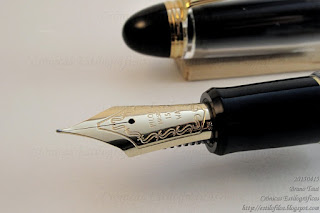Some time ago, I spoke about
a rather mysterious ink made by Pilot in the 1920s. That ink, by the name of
Bokujû (墨汁), was described as real
sumi (墨) ink adapted to be safely used in a fountain pen.
Sumi, let us remember, is the ink used in traditional
East Asian calligraphy, and it is made of vegetable soot and animal glue. As a result, it is hardly compatible with fountain pens—its particles in suspension would quickly clog the ink channels of the feed.
Many years after that ink was made, other companies have tried to create similar inks in one way or another. Platinum’s Carbon Ink and Sailor Kiwa-Guro (極黒) might be the closest relatives—nano particles in aqueous suspension. Pilot does not make any pigmented ink, but named one of the Iroshizuku inks as
Take-sumi (竹炭), bamboo charcoal, giving a indirect reference to the traditional ink.
And there is another
sumi-inspired ink in Japan. Kobe-based stationery shop Nagasawa has an extensive catalog of inks made by Sailor. They are, in essence, Jentle inks in exclusive colors. But there is one unusual ink in this catalog also made by Sailor. Contrary to the case of Jentle inks, the smell of this one is completely different—it is scented, and its fragrance is that of traditional
sumi ink.
The name of the ink is not really clear. The label says “Fountain pen black ink.
Sumi scent”. The last two ideograms, 墨香, could be read as
bokkô or
sumi kaori.
 The label reads "Fountain pen ink,
The label reads "Fountain pen ink, sumi
scent."
As for the color of the ink, it is a fairly deep black, neutral color. Its chromatography does not show any non-black/grey dye.
To my knowledge, this is the only scented ink made by Sailor. And of all fragrances, that of
shodo (書道) ink was chosen. Not flowers, not perfume—
sumi ink.
Pilot Custom 823, WA nib – Montblanc White Forest
Bruno Taut
Nakano, June 3rd, 2015
etiquetas: Japón, Sailor, Platinum, Pilot, tinta





























































